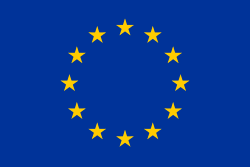草稿:歐洲象徵

歐洲自古以來擁有許多象徵符號,其中最著名的就是神話人物歐羅巴。1950至60年代,歐洲理事會引入幾種標誌;1985年,歐洲共同體為自己創建附加標誌;1993年,歐洲聯盟繼承這些標誌。現在,這些歐盟標誌代表支持歐盟政策,以及歐洲人民倡導歐洲一體化的政治立場。
歐羅巴和公牛
[編輯]
古希臘時代,希羅多德將「Europa」用作地理術語,指已知世界的一大塊領地;在當時認知的地理範圍內,是指色雷斯或伊庇魯斯的部分地區,這個用詞也出現在荷馬的阿波羅讚歌。羅馬時代,兩位影響頗大的地理學家斯特拉波和托勒密,將其用作塔納伊斯以西大陸的地理術語。加洛林王朝時代,「歐羅巴」首次被用作為文化術語,指拉丁基督教世界的領土。
歐羅巴(Europa)是一個女性化名字,在赫西俄德作品中是一位女神的名字。同時,在希羅多德最早講述的傳說中,她是一位被希臘人(希羅多德認為是克里特人)綁架的腓尼基貴婦的名字。奧維德的古典著作《變形記》描述,歐羅巴不是被希臘海盜綁架,而是被變身公牛的宙斯誘拐。根據記載,宙斯變身為一頭溫順的白色公牛,混在歐羅巴父親的牛群,當歐羅巴和侍女正在採花時,她看見公牛並爬上公牛背,宙斯趁機跑到海裏,帶着她游到克里特島。宙斯向歐羅巴透露自己的身份,令她成為克里特島的第一位王后,並送給她一件赫淮斯托斯製作的項鍊,以及另外三份禮物:塔羅斯、萊拉普斯和萬無一失的標槍。後來,宙斯在星空中創造白色公牛的形狀,也即是群星的金牛座。

歐羅巴和公牛的起源神話自希臘-羅馬時代以來,一直是歐洲藝術常見的主題,也經常被提及到與歐洲大陸和現代歐盟的關係;因此,它不僅被可以被視為地名學,也可以被視為歐洲象徵或化身。例如,歐羅巴和公牛的雕像位於歐盟的幾個機構,以及出現在希臘的2歐元硬幣;歐洲議會保羅-亨利·斯巴克大樓的圓頂上,有一幅由阿利吉·薩蘇創作的大型馬賽克,描繪歐羅巴和公牛的場景,以及其他希臘神話元素。
除此之外,公牛圖案也出現在所有歐盟國家新設計的居留證的左上角。[1]
歐洲女王
[編輯]
歐洲女王(拉丁語:Europa Regina)興起於16世紀風格主義時期,是在地圖繪製中將歐洲描繪成一位身着皇室禮服的女王形象。[2][3] 這份地圖的羅盤方位西邊朝上,伊比利亞半島是頭部,戴着形似加洛林帝國環冠的王冠;比利牛斯山脈是頸部,法國(高盧)構成上胸部;神聖羅馬帝國(日耳曼尼亞和其他領土)是軀幹的中心,波希米亞(早期描繪中有時是奧地利)是女王的心臟(或腰間的一枚勳章);她的長袍延伸至匈牙利、波蘭、立陶宛、立窩尼亞、保加利亞、莫斯科、馬其頓和希臘;她的手臂由意大利和丹麥組成,左手握着權杖、右手握着十字聖球(西西里島)。[4] 大多數描繪只顯現非洲、亞洲和斯堪的納維亞半島的邊角,不列顛群島也呈現示意圖的形式。[4]
The first map to depict Europe in this manner was made by Johannes Bucius Aenicola (1516–1542) in 1537.[5][6][7] Though much about the origination and initial perception of this map is uncertain,[7] it is known that Putsch maintained close relations with Holy Roman Emperor Ferdinand I of Habsburg,[7][8] and that the map's popularity increased significantly during the second half of the 16th century.[7] Europa Regina was introduced in the 1530s by the Austrian cartographer Johannes Putsch, possibly with the intent of depicting Europe as the spouse of Charles V of Habsburg, who aspired to become the universal monarch of Christendom and reigned over numerous realms including the Holy Roman Empire, Austrian lands, Burgundian territories, and the kingdom of Spain.[4][8] Arguments in favour of this hypothesis are the westward orientation of the map to have Hispania as the crowned head, said to resemble the face of Charles V's wife, Isabella of Portugal; the use of the Holy Roman Empire's insignia – its Carolingian crown, sceptre and orb – and the portrayal of Habsburg realms (Austria, Bohemia, Hungary, Germany) as the heart and centre of the body; the design of the gown, which resembles the contemporary dress code at the Habsburg court.[9][8][4][10] As in contemporary portraits of couples, Europa regina has her head turned to her right and also holds the orb with her right hand, which has been interpreted as facing and offering power to her imaginary husband, the emperor.[10] More general, Europe is shown as the res publica christiana,[8] the united Christendom in medieval tradition,[4] and great[2] or even dominant power in the world.[10]
Another allegory is the attribution of Europe as the paradise by special placement of the water bodies.[8] As contemporary iconography depicted the paradise as a closed form, Europa regina is enclosed by seas and rivers.[8] The Danube river is depicted in a way that it resembles the course of the biblical river flowing through the paradise, with its estuary formed by four arms.[8] That Europa regina is surrounded by water is also an allusion to the mythological Europa, who was abducted by Zeus and carried over the water.[10] Europa regina belongs to the Early Modern allegory of Europa triumphans, as opposed to Europa deplorans.[11]
歐洲之父
[編輯]查理曼(拉丁語:Carolus Magnus)是法國和德意志君主制度的創始人,被譽為「歐洲之父」(Pater Europae)。[12][13] 他於公元800年建立加洛林帝國,是西羅馬帝國覆滅以來歐洲最廣泛的統一,並且帶起形成泛歐洲身份的卡洛林文藝復興,標誌着古典晚期的終結。[12][14] 同時,當時的知識和文化復興也深刻地影響西歐歷史。賦予查理曼大帝超越其軍事成就的傳奇地位。[12][15][16]

幾個世紀以來,歐洲王室一直試圖與加洛林王朝的遺產聯繫。例如:神聖羅馬帝國皇冠和拿破崙一世皇冠都被命名為「查理曼皇冠」;查理曼的私人寶劍「Joyeuse」,從11世紀開始被用作法國國王的加冕劍。[17] 法國文藝復興作家讓·勒邁爾·德·貝爾熱進一步美化對查理曼的崇拜,他認為這位皇帝是著名的「皇權傳遞」的一部分,這是源於特洛伊戰爭時期的特洛伊國王普里阿摩斯,引申到希臘神話中的「眾神與人類之父」宙斯。
現今查理曼大帝的泛歐象徵價值,很大程度在於他被視為法德友誼的化身,這種友誼在兩次世界大戰期間的長期敵對狀態中並不存在,但在歐洲一體化進程中卻變得不可或缺。所以在1952年歐洲委員會旗幟設計競賽中,好幾個未能獲得成功的設計方案,都讓人聯想到金焰旗;這是公元800年教皇良三世在聖彼得大教堂,為查理曼加冕時贈予的旗幟。[18][19] 同年,漢斯·馮·亨蒂希(Hans von Hentig)教授也指出,查理曼帝國與現代歐洲一體化之間存在相似之處。[20] 歐盟委員會還將布魯塞爾的其中一座中心建築,以查理曼的名字命名為查理曼大廈,以此來彰顯查理曼大帝。1949年開始,德國亞琛每年都會向歐洲統一的貢獻者頒發查理曼獎,獲獎者包括阿爾契德·加斯貝利、讓·莫內等人物。國際事務報刊《經濟學人》的每一期刊物,都會開設一個名為「查理曼筆記」(Charlemagne's notebook)的專欄,重點關注歐盟事務。[21] 2010年,歐洲議會議長耶日·布澤克在查理曼青年獎頒獎典禮的講話中說道:[22]
| “ | 請你想像一下,一千二百年前查理曼大帝的時代。那時,他就已經憧憬着一個統一的歐洲。想想從那時起發生了多少場戰爭,歐洲流了多少血。我們被仇恨吞噬,被情緒所左右,無法達成共識。當時人們憧憬着一個統一的歐洲,但卻未能實現。我親愛的年輕朋友們,我們必須牢記,永遠銘記這一願景。 | ” |
後來,也有一些君主被冠以「歐洲親戚」的稱號,例如:英國維多利亞女王(歐洲祖母)、丹麥國王克里斯蒂安九世和黑山國王尼古拉一世(兩者均為歐洲岳父);然而,這些稱號純粹是得名於其後代子孫的聯姻關係,並不具備更廣泛的象徵意義。
主保聖人
[編輯]羅馬天主教會尊崇六位聖人為「歐洲主保」。1964年,教宗保祿六世冊封努西亞的本篤為「全歐洲的主保聖人」。[23] 1980年至1999年期間,教宗若望保祿二世先後冊封基里爾和美多德、彼濟達、聖加大利納和埃迪特·施泰因為共同主保。[24][25]
據信自14世紀初以來,整個歐洲大陸都被奉為歐洲聖母的庇護所。[26]
旗幟
[編輯]
歐洲委員會於1955年推出「歐洲旗」,最初旨在作為「整個歐洲的象徵」。[27] 由於1985年歐洲經濟共同體(EEC)採納該旗幟,因此被作為EEC繼承機構的歐洲聯盟(EU)採納,該旗幟如今與歐盟緊密相關,至少自2000年代初開始,它不再單純具有代表「整個歐洲」的功能。21世紀初的顏色革命中,親歐盟抗議者尤其選擇揮舞該旗幟,例如:2004年白俄羅斯抗議活動[28]、2013年烏克蘭親歐盟派系在廣場起義使用的旗幟,以及2016年英國去留歐盟公投運動中的親歐盟派系。
1955年之前採用的泛歐旗幟
[編輯]

在歐盟政治制度發展之前,代表歐洲的旗幟僅限於統一運動,其中最受注目的是歐洲運動的聯邦主義旗,旗幟設計為白底綠色大「E」,以及國際泛歐聯盟(1922年)的「泛歐洲旗」(Pan European flag)。[29]
另見
[編輯]參考資料
[編輯]- ^ Demey, Thierry. Brussels, capital of Europe. S. Strange (trans.). Brussels: Badeaux. 2007: 387. ISBN 978-2-9600414-2-2.
- ^ 2.0 2.1 Landwehr & Stockhorst (2004), p. 279
- ^ Werner (2009), p. 243
- ^ 4.0 4.1 4.2 4.3 4.4 Werner (2009), p. 244
- ^ Bennholdt-Thomsen (1999), p. 22
- ^ Borgolte (2001), p. 16
- ^ 7.0 7.1 7.2 7.3 Schmale (2004), p. 244
- ^ 8.0 8.1 8.2 8.3 8.4 8.5 8.6 Wendehorst & Westphal (2006), p. 63
- ^ Europeanness in Early Modern Latin Literature, Isabella Walser-Bürgler, p. 60
- ^ 10.0 10.1 10.2 10.3 Werner (2009), p. 245
- ^ Werner (2009), pp. 243ff
- ^ 12.0 12.1 12.2 Riché, Preface xviii, Pierre Riché reflects: "[H]e enjoyed an exceptional destiny, and by the length of his reign, by his conquests, legislation and legendary stature, he also profoundly marked the history of Western Europe."
- ^ Der Karlspreisträger Seine Heiligkeit Papst Johannes Paul II. außerordentlicher Karlspreis 2004. Karlspreis.de. [2012-01-01]. (原始內容存檔於17 January 2012).
- ^ Home – Humanities Division – UCLA. Humanities Division – UCLA.
- ^ karlspreis.de. karlspreis.de. [2012-01-01]. (原始內容存檔於17 January 2012).
- ^ Chamberlin, Russell, The Emperor Charlemagne, p. ???
- ^ Coronation sword and scabbard of the Kings of France, Decorative Arts : Early Middle Ages, Louvre
- ^ Proposals for European flags from Arsène Heitz (1952–1955). cvce.eu. 8 November 2011 [2013-08-06].
- ^ Proposals for European flags from Arsène Heitz (1952–1955). cvce.eu. 5 January 1952 [2013-08-06].
- ^ 'Charlemagne and coke' from the Frankfurter Allgemeine Zeitung (5 January 1952). cvce.eu. [2013-08-06].
- ^ «Must try harder». The Economist.
- ^ europarl.europa.eu. europarl.europa.eu. 11 May 2010 [2012-01-01].
- ^ Johan Fornäs, Signifyingo Europe (2012), p. 255f.
- ^ Egregiae Virtutis. [26 April 2009]. (原始內容存檔於4 January 2009). Apostolic letter of Pope John Paul II, 31 December 1980 (拉丁語)
- ^ Johan Fornäs, Signifyingo Europe (2012), p. 255f.
- ^ Gibraltar Our Lady of Europa 20p. www.westminstercollection.com. [2020-04-30]. (原始內容存檔於3 March 2020) (英語).
- ^ The European flag, Council of Europe. Retrieved 27 October 2016.
- ^ Mite, Belarus: Scores Arrested, Opposition Leader Hospitalized After Minsk Protests, rferl.org, 20 October 2004 [5 August 2007])
- ^ CVCE (編), The European flag: questions and answers, [25 June 2014]
外部連結
[編輯]- The symbols of the EU – Europa
- Council of Europe Logo and the European Flag – Council of Europe
- Why the European flag has been chosen: Resolution (55) 32 adopted by the Committee of Ministers of the Council of Europe (8 December 1955) – CVCE (Previously European NAvigator)
- The European Anthem and downloads – Council of Europe
- European anthem – CVCE (Previously European NAvigator)
- European commission poster – CVCE (Previously European NAvigator)
- The European emergency number 112 – European Emergency Number Association (EENA)
- The European emergency number 112 – European Commission
- Europe's name – A website on illustrations of Europa in relation to the Continent
- The Symbol's Role in the Creation of a European Identity – A dissertation paper.



